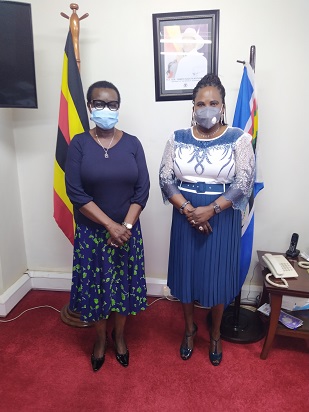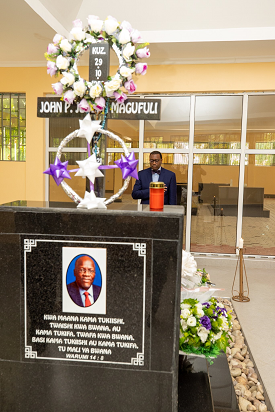Emma Mugisha, Stanbic Bank Executive Director, Sarah Ssewanyana, Executive Director for EPRC, Ernest Rubondo, Executive Director for Petroleum Authority of Uganda and Mona Muguma-Ssebuliba, Chief Executive for aBi Finance, displaying signed MoUs at Sheraton Hotel
The housing and agriculture sectors could earn Uganda an extra eight billion US Dollars in the next phases of oil and gas developments.
With such earnings, Uganda can avoid the “dutch disease” if the real estate and agriculture sectors are linked to oil and gas. Economists have long known that large resource discoveries could be harmful to economies in the long term, a phenomenon that was named Dutch disease following the effects of the Netherlands’ gas discovery in the North Sea.
The Petroleum Authority of Uganda Executive Director Ernest Rubondo says the linkages in agriculture, housing and oil and gas bring new opportunities for the country. A housing deficit has been observed in the Albertine districts of Hoima, Kikuube, Masindi and Buliisa as more people move there for opportunities as the country embarks on the last journey towards oil production.
Previous studies have indicated that 150,000 workers will be required at the peak of the project. Oil and gas activities are also expected to attract over one million people in the Albertine Graben districts during the development and production stages.
“You can therefore trust that the aspect of food going to be very important in this regard. And it is very exciting to hear that it is already being extended not only to provide food to people in the oil and gas sector in the Albertine but it’s creating opportunity for medium and long-term to strengthen the export of food” said Rubondo.
He says the developments in the oil and gas sector and its infrastructure present an extraordinary opportunity for growth in demand for agriculture produce, housing, health services, education and hospitality. Rubondo was speaking at the signing of a Memorandum of Understanding with the Economic Policy Research Centre (EPRC) on Thursday.
The EPRC is over the next months expected to undertake a study on the agriculture and housing linkages with the Oil and Gas sector. The over 300 million Shillings’ study will be funded through a tripartite co-funding arrangement by Stanbic Bank Uganda. While Stanbic Properties Limited will fund the Housing and oil and gas linkages study also to be conducted by the Think Tank.
EPRC is expected to earn over 250 million Shillings from the housing and oil and gas linkages study. The study is expected to provide up-to-date information about the housing stock and agricultural productivity for effective planning before oil production begins by 2025.
“This study is going to point at areas which are already in place, at areas which need to be in place, and those that need to be in place but are not in place” Rubondo explained. In the housing sector, preliminary statistics show that the housing needs in Albertine for expected direct and induced workers remains largely insufficient.
Real estate dealers in Hoima, Kikuube, Buliisa and Nwoya districts have in the past reported a sharp rise in prices. The residents of Hoima city and its suburbs have also reported a spike in rental costs.
Some residents in Hoima have reported a challenge in finding decent houses even before more people get into the region to construct the oil and gas infrastructure like the refinery and central processing facility.
When construction begins, the blue-collar workforce is expected to fill s up in hotels, motels, and so-called man camps. Sometimes, companies even rent blocks of houses to put their employees.
“I trust that the findings of these studies will go a long way in informing ongoing efforts in the agriculture and housings sector,” said Rubondo. The studies will focus on the districts of Hoima, Buliisa, Masindi, Kikuube, and Nwoya which form the Albertine Graben.
Districts to be covered by the East African Crude Oil Pipeline will be covered. Lands and Urban Development Ministry Permanent Secretary, Dorcas Okalanyi said it is important the housing needs for the oil and sector are critically addressed. She says as the construction works begin, the requirement of temporary or permanent structure will be needed.
“This housing is very critical and is urgently required in the construction phase. Indirectly, there is what we call housing for induced workers along both the upstream and downstream of oil and gas activities” said Okalany.
She says one of the observations by her ministry is that there is an increase in population in the Albertine and the districts along the East African Crude Oil Pipeline. “This shift needs to be adequately planned if we have to leave anybody not worse off, “said Okalany
The head of Agricultural extension at the Ministry of Agriculture, Dr Deus Muhwezi says the study on agriculture is timely because it will position the country largest sector in the oil and gas sector so as to avoid the so-called Dutch disease.
There has been fear that Uganda may abandon the agriculture sector in favour of oil, gas and minerals exploitation.
According to the UN’s Food and Agriculture Organization, Uganda’s fertile agricultural land has the potential to feed 200 million people. In the fiscal year 2020/2021, agriculture accounted for about 23.7 per cent of GDP, and 31 per cent of export earnings. The UBOS estimates that about 70 per cent of Uganda’s working population is employed in agriculture.
-URN





